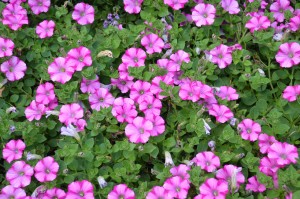Petunias (Petunia x hybrida) are top performing summer flowering annuals. There are hundreds of colorful varieties to beautify any flower bed or container garden.
Petunias are divided into three basic types:
- Grandiflora petunias grow 8-12 inches tall and 8-10 inches spread; they start out upright branched and bear large size 4 to 5 inch wide blooms. Ideal for flower beds, window boxes, and other containers. By mid- summer vegetation and flowers spill over the sides of containers.
- Floribunda (or Multiflora) petunias grow 8-12 inches tall and 8-10 inch spread; produce smaller, more abundant flowers that withstand harsh weather conditions. They’re much more versatile and can be planted in areas not suitable for Grandifloras.
- Spreading petunias grow 8-10 inches tall and 2-3 feet spread; they trail along garden beds as a non-stop blooming ground cover or spill over edges of containers.
Hundreds of cultivar series are available starting with Waves®, Cascadias®, Supertunias®, Madness®, and Sulfinias® to list just a few. Double and single blooms offer a selection of solid and multi-colored flowers.
Petunias ask for weekly watering and full day sunlight (best) to achieve maximum blooming potential. They will grow in partially shaded locations but bloom less and plants tend to stretch. Petunias are heavy feeders. Before planting petunias work lots of compost into the soil and broadcast a slow release fertilizer over the entire bed. By mid-summer, plants, particularly those in containers, may become nitrogen deficient. Bottom leaves are first to turn yellow and plants bloom more sparsely. Feed container plants with a water soluble fertilizer such as Miracle-Gro®, Peters®, or Schultz® weekly or twice monthly at label rates.
When purchasing plants at garden center, select those with compact habit and unopened buds. Deadhead petunias, e.g. remove flowers to prevent or eliminate seed heads. In mid-season (late July, set your lawn mower to highest setting (5 inches recommended) and mow over taller varieties. Fertilize with 10-10-10 or equivalent product and irrigate. This will re-invigorate the petunia bed to bloom into mid- to late-fall.
Petunias are disease and pest resistant. Do not plant petunias in the same garden area more than three consecutive years to prevent buildup of soil -borne diseases.



 Posted in
Posted in 
